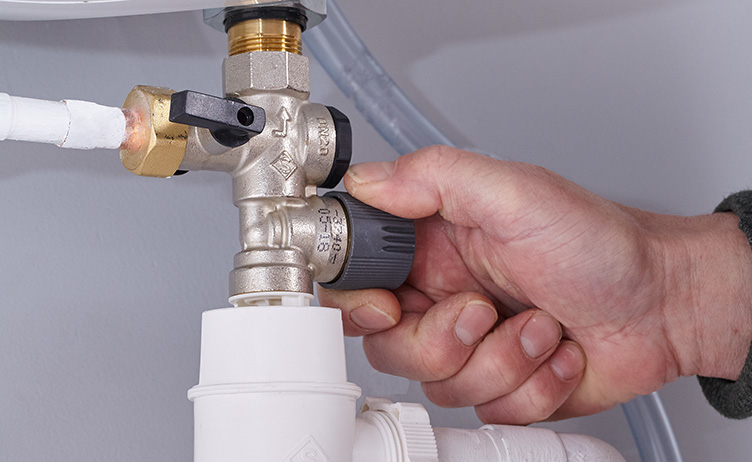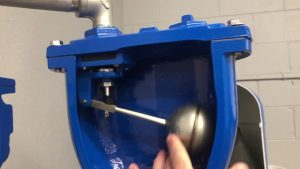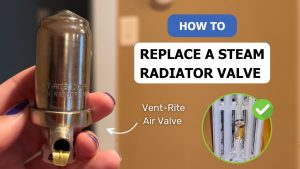Understanding the importance of a ball valve in a water heater system ensures seamless operation and safety. This valve is typically located near the water inlet and outlet pipes on your water heater. It serves the primary function of controlling the flow of water into and out of the heater.
In the world of plumbing, ball valves, and gate valves serve similar but distinct purposes. The key differences include design, operation speed, and structural and operational variances.

What is a ball valve?
A ball valve is an essential device in a plumbing system that regulates water flow. Composed of a hollow ball inside, the valve uses a handle to control the ball’s rotation, thereby controlling water flow.
Explanation of how a ball valve works
The ball valve handle can shut off or allow water flow in a quarter turn. When aligned with the pipe, it signifies an open valve and a perpendicular handle indicates a closed valve.
Advantages of using ball valves in water heaters
Ball valves are an excellent choice for water heaters due to their precise flow control, leak-proof properties, and versatility. They are designed to last longer and are less likely to leak than other valve types. Moreover, water ball valves work effectively under high temperatures and pressure, making them ideal for water heater systems.
Types of Valves on Water Heaters
Two main valves commonly found on water heaters are the gate and the ball valves. Each has its operation mechanism and joint issues.
Different Valves Found on Water Heaters
The gate valve operates by raising or lowering a ‘gate’ inside the valve to control water flow. It’s usually more affordable but prone to failure as they age.
The ball valve operates using a lever mechanism connected to a ball with a hole through the center. The design allows for a secure open or closed position, making them more reliable and easy to operate.
Common Issues with Gate Valves on Water Heaters
One common issue with gate valves is a failure to close or open when needed. This is mainly due to age-related wear and corrosion. They’re also prone to ‘dezincification,’ which can cause the stem to snap off in certain water conditions.
Importance of a ball valve on a water heater
A ball valve is indispensable in maintaining and operating a water heater system. Its principal function is to regulate water flow and, in emergencies, halt it rapidly.
Why a ball valve is essential for water heater maintenance
- Regulating water flow: An adequately installed ball valve allows precise water flow control to a water heater system.
- Emergency Situations: In the event of a leak or failure, a ball valve can quickly stop water flow, mitigating damage.
Benefits of having a functioning ball valve on a water heater
- Reduced Wear: Using a ball valve can prolong the life cycle of the water heater system.
- Efficient temperature control: Apart from water flow, the ball valve also aids in regulating water temperature within the system.
Where is the ball valve on a water heater?
In your quest for improved home maintenance, you might wonder, “Where is the ball valve on a water heater?” Rest assured, it’s pretty easy to locate!
Location of the ball valve on a water heater
The ball valve: Typically, it is situated nearby the water heater. You’ll find it connected to a copper pipe, running parallel to the pipe when the valve opens.
Tips for identifying and accessing the ball valve
Remember, the handle of the ball valve is straight, which gives ease of recognition. If the water heater is in a tight space or isn’t easily accessible, you can use a flashlight to illuminate the area.
If you are still facing difficulty finding or accessing the valve, don’t hesitate to seek the help of a professional plumber. They come equipped with the knowledge and tools to handle such situations.
Maintenance and care of the ball valve
Ball valves, usually utilized in water heaters, among other applications, are essential in controlling the flow of fluid or gas medium. While designed to be highly durable, regular maintenance and quality checks extend their lifespan and prevent preventable accidents.
Instructions for proper maintenance of the ball valve
Ensuring the longevity of your ball valve largely depends on good care. It’s crucial to adhere to Manufacturer’s guidelines, including regular inspections and replacements.
Preventive measures to ensure the longevity of the ball valve
Considering preventive measures is part of good maintenance practices. This could include:
- Regularly assessing the ball valve for wear and tear
- Replacing the valve as per the projected schedules
- Opting for three-piece ball valves in high cycle or high-pressure applications.
This approach saves repair costs and enhances plant safety by preventing hazardous leaks.
Conclusion
Utilizing a ball valve on a water heater significantly controls and stops the water flow, ensuring your heating system’s smooth and efficient operation. Understanding the precise location and function of a ball valve optimizes routine maintenance of appliances, ensuring they remain in good condition and prolonging their lifespan.
Importance of having a functioning ball valve on a water heater
Ball valves deserve proper attention within various settings, including a home’s water heating system. They offer reliable and firm control over the water flow, contributing significantly to efficient heating and reducing the risk of overheating.
Key takeaways for maintaining and upgrading ball valves
Maintenance of your water heater isn’t just about the heater itself but also its auxiliary components like ball valves. When needed, regular quality checks and prompt replacements can prevent potential issues, such as leaks or malfunctions.
Advancements in ball valve design, like the three-piece ball valve, offer easy replacement of the center section and seals, enhancing their durability and lifespan. Therefore, consider opting for these advanced versions when upgrading your water heater’s ball valve.
FAQs
Knowing the location of the ball valve is crucial for emergencies like leaks or repairs, as it lets you shut off the water supply to your water heater quickly.
The ball valve typically has a lever handle that can be turned by 90 degrees. It may also have markings such as “on/off” or “open/close” for easy identification.
While replacing or repairing a faulty ball valve yourself is possible, we recommend contacting a professional plumber with experience with water heaters for the best results.
Occasional leaks from the ball valve can happen due to wear and tear or sediment build-up. If you notice persistent leakage, it’s advisable to have a professional inspect and fix the issue.
Lubricating the ball valve on a water heater is generally unnecessary unless it becomes stiff or challenging to operate. In such cases, a silicone-based lubricant designed explicitly for valves can help.












